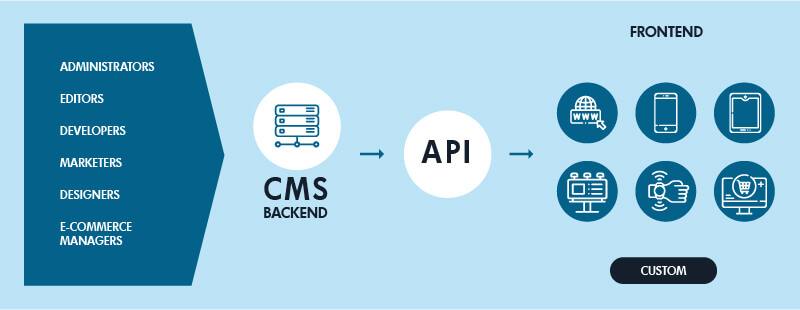Learn everything about Headless in 11 minutes
The traditional monolithic web architecture of an application could be no longer enough. Headless is the fresh technology to pursue. It allows you to build a modern and efficient sales strategy focused on providing more than excellent CX.
While e-commerce companies struggle with growing customer expectations, the competition does not rest or sleep. E-commerce is a fiercely competitive environment. To not fall out of the loop, or for that matter the market entrepreneurs need to create online sales platforms to attract customers. The fight over any potential customers is fierce. The traditional monolithic web architecture of an application could be no longer enough. Headless is the fresh technology to pursue. It allows you to build a modern and efficient sales strategy focused on providing more than excellent CX.
Headless solutions provide IT flexibility and dynamism for adapting to any current and future consumers’ needs. That is what the most developed businesses aim at achieving. Most important, with Headless approach, the adaptation works well with any customer communication channels, even the ones that will exist in the future. So overall, it leaves us a lot of room for further development and scaling up.
What exactly is headless?
Headless is a brand-new concept in software development. Its architecture separates the front-end application layer (what clients see), from the back-end (what the developers see while working on, e.g., an application). For these both sides to communicate requires designing an API (Application Interface), in simple words it works like a connector of some type.
Such an approach supports organizations in responding quickly to any users’ additional needs and offers them groundbreaking digital experiences. Currently, we find the technology as a combination of two as Headless CMS (Content Management Systems, or in Headless e-commerce used in modern online stores.
Traditional CMS vs. Headless CMS
Let’s start with the fact that every online store model comprises three key elements:
- Database stores all product data incl. price, name, description, and its images.
- Back-end - the systems’s IT backbone, supports all store features and internal management and configuration tools.
- Front-end is simply the storefront, displays processed database info to end-users.
The major difference between the traditional CMS systems (e.g. Wordpress) and Headless CMS lies in classic approach to programming. While the CMS favors a tight connection between the front-end and back-end, Headless grants independence to each of these layers. For that reason, we call traditional systems, also monolithic. They offer a set of features for creating content and impact how it displays to buyers.
CMS-based technologies are used to prepare the presentation layer. However, the idea no longer works or holds water because of the growing customers’ demands. Also, often alternatives seem to be very difficult or even impossible to use in a traditional CMS. That is when Headless solutions come to our rescue. Headless CMS transforms the way we deal with the visual layer via API interface. It is now used to deliver content everywhere. Losing the ties between frontend and backend gives all developers the freedom to choose any frontend technologies.
The content is designed just once and unified it in the app’s backend. As a result, we can display it on various devices, computers, smartphones, tablets, TVs or even VR and IoT devices. Even though each device display is different, the content will adopt to the user’s device. Because the backend lets us define a separate view for online viewed in a mobile app, or in fact, or for any other point of contact. The goal is to provide the best experience for users on any device. It is worthwhile, as each channel gives us unique presentation capabilities.

Presenting content on different devices and in different ways is the dominant feature that Headless’ is ahead of other technologies on the market.
API - the heart of headless
Headless design is based on API. We can say that API acts as a bridge between the frontend and backend. It separates these two parts from each other and enables communication between different applications. Raw data on the server supports the JSON or XML format. Why is it important? There is no need to generate content per each device and put on the server.
We ‘retrieve’ the uploaded data from the server while it is rendering the client-side version depending on the device used. It displays the content optimized to the client’s app settings and parameters. And it does not matter if it is a web application in a browser, or a mobile app on any smart devices (smartphone or tablet, or on a TV). In a matter of seconds, the API passes on that information or data from the backend to any system which needs its data. The reason behind it is can do it is that the content itself is detached from any pre-defined structure.
Benefits of headless
The headless model is gaining popularity all over the world - and here is why. The architecture type concentrates on the user-oriented omni-channel following significant sales increase. Headless supports, and will continue to do so, any customer communication channel. Content display adopts to varied devices along with the user interfaces.
It does not require any changes in the application back-end. IT grants overwhelming flexibility, increase our options for implementing new, innovative solutions. Also, developers, marketing or e-commerce managers can on their own create unique customer experiences in a shorter time than before. Besides, headless is perfectly compatible with PWA/TWA applications, which are conquering the e-commerce market.
Omnichannel
Growing customer expectations are making the purchase path expand day by day. To keep up with customer demands, brands need to readjust their IT tools to various sales channels. However, just switching to a multi-channel sales mode is not sufficient. What is then? Integration of all customer touch points for building a consistent brand image.
That is when the omnichannel comes in. The strategy relies on combing all sales channels into one. Its effectiveness lies in a unified shopping experience across all sales channels. However, with omnichannel you need to be flexible, the traditional approach won’t work. Because it holds on the interdependence on the frontend and backend, and multi sales channels synchronization. It has no chance with Headless solutions which provide flexible and scalable architecture. For one, each customer touch point uses a single data source.
Changes in the visual layer do not affect the backend layer, unlike monolithic architecture where a change in one layer goes hand in hand with changes in the other. Even if some modifications become much simpler and implementing new sales channels. Also, it is possible to create front-end layers per each sales channel individually. There is always room to extend the application features to reach new customer touch points and maintain a consistent brand image.
Fast content delivery
Headless technology gives a power boost to the page loading speed. It is not the only key factor that is important to end-users. The other one is comfort and significant SEO visibility. Headless-based pages have a higher position in search engines. Using API calls (i.e. requests sent to/from server) lets to retrieve content.
In the scenario, resources are not shared, so we avoid system overloading, which often happens in the traditional model. The browser’s memory (cache) executes required scripts, causing the number of queries to drop. As a result, we guarantee system users faster system operation.
Do you want to create an innovative web application?
Check what we can do for you!
UX
Increasing customer demands is not the only reason online store owners welcome multichannel in e-commerce. Delivering consistent experiences at every touch point is. Headless constantly supports specialists and UX designers in meeting the customers’ wildest expectations.
By using bespoke tools, it is possible to personalize UX every sales channel and add top-of-the-line features. Also, user satisfaction goes up because of the page display speed. Customers seeing everything is running smoothly, buy more. Conversation rate goes off the charts.
Headless mobile
The study held by Gemius/PBI in August 2020, 24.2 million people accessed the internet via different smart devices. Overall, the ratio of PC and laptop users lost the lead to mobile users by over 3 million. Polls from previous months or even years show smartphones and tablets are more popular and the trend is constantly increasing.
Acting now and adapting websites to mobile standards is inevitable. There are bigger limitations to optimizing pages for mobiles. However, the headless model supports the mobile-first idea and makes it perfect for the task.
We can create specialized mobile site versions and ones suitable for desktop use. As the headless separates the frontend and the backend, the client can use an application in any technology. Designing a mobile application has never been easier.
Flexible design
Nowadays IT flexibility is something every business strives for. You can rely on Headless as it provides you with unlimited possibilities. Enterprises can customize any platform features and create unique UX in multiple channels. It is much easier to follow market trends if you can change or add features without worrying how they will affect the entire system.
Separating the backend and frontend layers enables the use of any programming language, framework, or technology. It is golden as you can shape anything to your business needs for improving the old or introducing a new sales channel. The work relies on deploying another API endpoint. You design a communication channel between the main platform, and a new POS (point of sale).
![]()
Security
The headless architecture provides much greater security for any stored information and databases. Since the frontend and backend layers are separate, a website user cannot access the system’s internal database. Frequently system parts are on different servers on purpose to increase data protection.
The SEO question
It is a common misconception that CMS-based is better than Headless, as it has more built-in features that help to manage SEO aspects. Headless CMS doesn’t have these features by default. Yet you can configure it to provide the same ones and expand them even further - provided you think it through well.
Building SEO-related features is happening in the system’s backend. During the project, consider such aspects as the metadata, URL structures, HTTPS, or XML site map. Note Headless CMS solves the page performance issue. As we all know, website loading speed is a very important SEO factor. It also has a real impact on your search engine position and conversions. Google indexes slow-loading pages and favors the faster ones. It is true for mobile searches, where every millisecond matters in the overall SEO ranking.
Headless PWA
When you speak Headless, you must say PWA (Progressive Web Application), because they go together. The technology helps in creating a user interface for Headless CMS-based content. By combing these two options, you get twice the benefits. You can create efficient, highly accessible, and future-proof platforms.
The Internet calls for a mobile approach, as its traffic is going through the roof. Smartphones stopped being phones, they became versatile tools used for work and entertainment purposes. Because of the shift, a new application generation emerged: the Progressive Web Apps. Why is the mobile standard better? The PWAs are not native apps, because users do not install them. They resemble the ‘old’ ones because they work and provide all standard application features and more.
Let’s say a user visited a website that offers a PWA. Then, a special web notification would appear asking whether one would want to use the app on their devices. By clicking ‘Agree’ then the icon would appear on their home screen. The progressive app launches like a regular web page, yet you start them by pressing an application icon. There is more to PWAs, they work offline, can use built-in functions in a device (e.g. camera, geolocation feature), and send push notifications. Also, they provide a mobile user-friendly interface, are way responsive compared to the app designed in the old standard.
PWA tackles all major problems the mobile market struggled for years - providing a rich mobile experience to all users. You do not need to search for them in app stores, wait until they install and/or update themselves before using them. ‘Trouble-free’, run fast and smooth, and enable to use of all features the original website offers.
From a customer’s perspective is all about the comfort of use. If everything works well, one will purchase within a matter of seconds. Yet, if they run into even minor trouble, e.g., too long loading time, they will turn away. The seller loses a customer, while the potential buyer gets an inadequate experience. The incredible PWA speed is the most crucial quality it offers, followed by an excellent UX and positive enforcement to come back.
The PWA’s standard extension is TWA (Trusted Web Activity), which is a technology that connects the entire world of web and mobile applications. Its purpose is to, so to speak, pack all PWA-based web services into a special container. Having the app like you can sell it on a marketplace, e.g., Google Play. Users visiting the app mobile store won’t even know it is something way better than a typical mobile app.
We dare to say that PWA or TWA-based apps are the solutions from the future, and they will work in every industry. Its advantages go beyond expectations, however, will make a tremendous difference in e-commerce.
Combine or not to combine PWA and Headless?
Well, these two such strong and innovative technologies allow designing applications that offer the most revolutionary user experience. Such a duo guarantees unlimited IT flexibility and scalability for both applications and business. The market is hungry for these two aspects and TCO (Total Cost of Ownership). Whereas, a PWA app is cost-effective and is now the fastest way to develop compared to the Headless native app.
Also, the Headless back-end makes any PWA applications easy to update and remains open to further digital improvements. Such applications work smoothly and display the content that matches a specific device. However, even the best-designed front-end application cannot work without a solid back-end won’t satisfy our customers. Here, Headless CMS comes to the rescue. A powerful platform guarantees the information flow goes to/from the platform.

Who will most benefit from PWA?
Headless is the technology of the future. It is a perfect solution if your company values IT flexibility and freedom in adopting alternative solutions. Ecommerce is the industry that will go well with Headless. Also, if you are a business owner always facing new challenges, Headless will the answer to your prayers. No matter if it comes to meeting ever-growing customer expectations, or even experimenting with new technologies.
The API-based approach eliminates the limitations put by the traditional sales platforms. It is best for large enterprises because it offers many complex, unique business rules and processes. Also, Headless welcomes integration with external systems. Its flexibility makes it easier to integrate your sales platform with other systems or tools. Also, extending platform features and/or alternative solutions implementations becomes much manageable. There are no limitations to any specific system integration, so you can say the possibilities are endless, also with mobile development.
Mobile apps have unique programming requirements and differ from traditional websites. Headless still can optimize their operation. It provides a wide range of possibilities and does not force any User Interface method. The API delivers content from the same backend, so it does matter if the app uses iOS, Android or PWA. Separating frontend and backend helps developers a great deal. During designing an application, they focus on providing the best quality experience to end-users.
Invest in Headless if your company needs something more. You will get your money’s worth compared to traditional system solutions. Even though it is a bigger investment, its benefits will haunt you and won’t seize to surprise you. Especially if you’re an e-commerce seller with ambitions to go global or open new sales channels.
The Return On Investment increases along with the application’s performance, its speed, and significant savings in the long run. To know for sure, calculate the ROI based on the scale of your business and its development plans. Headless may not guarantee satisfactory results if your company operates in a smaller market with fewer target groups.
Do you need an efficient sales platform?
Our experts will be happy to advise you on optimal solutions.
Summary
The future is now and comes bearing unknowns. The biggest challenge for business owners is not so much being ready but adopting to it like a chameleon. Now, you know about Headless, the new technology tool that will help you change colors. Meaning you can alter your business model to welcome the inevitable evolution and match the digital reality and customer expectations.
Almost every week we hear about new examples and study cases on platforms that used Headless technology. Such global giants as Forbes (PWA in 2017), Twitter (Lite, 2017), Uber (2018), Nike (2018), Adidas (2018), BMW (2018), and Zalando (2018) already have it. Next, Netflix (2020), Amazon (Luna, 2020), and finally YouTube (release on the 25th January 2021 and works on a desktop). And these are some examples on the top of the head. Headless revolution is on the move. Jump on the bandwagon and let your clients and customers enjoy it too!



















